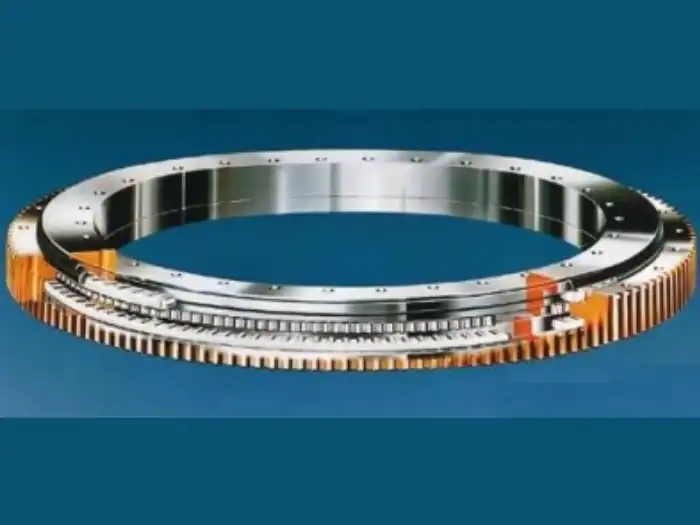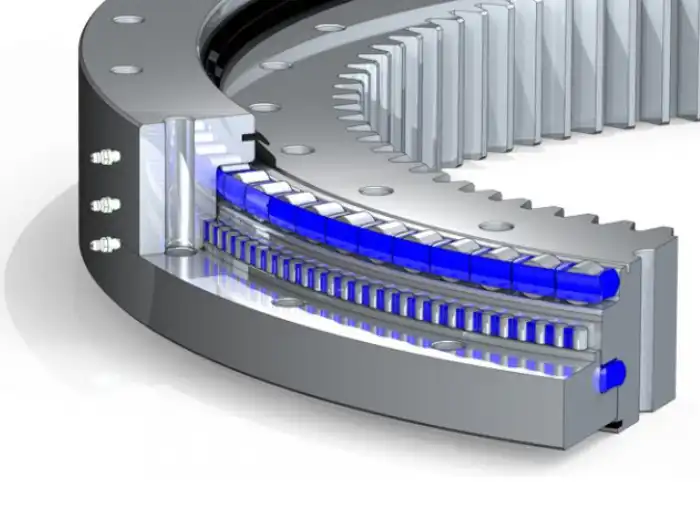How Are Three Row Roller Slewing Bearings Structured Internally?
Three Row Roller Slewing Bearings are sophisticated mechanical components that play a crucial role in various heavy-duty applications across multiple industries. These bearings are designed to handle enormous loads while providing smooth rotational movement, making them indispensable in equipment such as cranes, excavators, and wind turbines. But what sets them apart from other bearing types is their unique internal structure. This blog post delves into the intricate design of Three Row Roller Slewing Bearings, exploring how their internal configuration contributes to their exceptional performance. We'll examine the arrangement of the roller rows, the raceway design, and the materials used in their construction. Understanding these aspects will not only shed light on why these bearings are so effective but also help engineers and industry professionals make informed decisions when selecting bearings for their specific applications.

What are the key components of a Three Row Roller Slewing Bearing?
Raceway Rings
The raceway rings are fundamental components of Three Row Roller Slewing Bearings. These rings form the outer and inner races of the bearing, providing the pathways along which the rollers move. In a Three Row Roller Slewing Bearing, there are typically three separate raceway rings - one for each row of rollers. These rings are precision-engineered to ensure smooth rotation and optimal load distribution. The material used for these rings is usually high-grade steel, such as 50Mn or 42CrMo, chosen for its strength and durability. The surfaces of these rings are hardened and finely finished to reduce friction and wear, enhancing the bearing's overall performance and lifespan.
Roller Elements
The roller elements are the heart of the Three Row Roller Slewing Bearing. As the name suggests, these bearings feature three rows of rollers, each designed to handle specific types of loads. The rollers are typically made from high-quality steel, such as 16Mn, and are precision-ground to ensure uniformity. The first row of rollers is usually designed to handle axial loads, the second row for radial loads, and the third row for moment loads. This configuration allows the bearing to handle complex, multi-directional forces simultaneously, making it ideal for applications where loads come from various angles. The rollers are arranged in a way that optimizes load distribution, reducing stress on individual components and extending the bearing's service life.
Sealing System
The sealing system is a critical component of Three Row Roller Slewing Bearings, protecting the internal elements from contamination and retaining lubricant. These bearings often operate in harsh environments where dust, water, and other contaminants are present. The sealing system typically consists of multiple layers of seals, including rubber lip seals and metal shields. These work together to create a barrier against external contaminants while keeping the lubricant inside the bearing. Some advanced designs may incorporate labyrinth seals for even greater protection. The effectiveness of the sealing system directly impacts the bearing's performance and longevity, making it a crucial consideration in the overall design of Three Row Roller Slewing Bearings.
How does the internal structure of Three Row Roller Slewing Bearings contribute to their performance?

Load Distribution Mechanism
The internal structure of Three Row Roller Slewing Bearings is specifically designed to optimize load distribution. The three rows of rollers work in concert to handle different types of loads simultaneously. The axial row manages thrust loads, the radial row handles radial forces, and the moment row deals with tilting moments. This configuration allows for a more even distribution of forces across the bearing, preventing localized stress concentrations that could lead to premature wear or failure. The precise arrangement of the rollers and the design of the raceways ensure that each row operates at its optimal capacity, maximizing the bearing's overall load-carrying ability. This efficient load distribution mechanism is what enables Three Row Roller Slewing Bearings to handle the extreme loads encountered in applications like heavy construction equipment and large cranes.
Rotation Precision
The internal structure of Three Row Roller Slewing Bearings plays a crucial role in ensuring high rotation precision. The three separate rows of rollers, each with its own raceway, contribute to a more stable and accurate rotational movement. This design minimizes play and deflection, even under heavy loads. The precision-ground rollers and finely finished raceways reduce friction and promote smooth operation. Additionally, the bearing's structure allows for preloading, which can further enhance rotational accuracy by eliminating internal clearances. This high level of precision is particularly important in applications like machine tools and radar antennas, where even small deviations can have significant consequences.
Durability and Lifespan
The internal structure of Three Row Roller Slewing Bearings significantly contributes to their durability and extended lifespan. The three-row design distributes loads more evenly, reducing stress on individual components. This, combined with high-quality materials like 42CrMo4 steel, results in bearings that can withstand extreme conditions for prolonged periods. The structure also allows for effective lubrication, with channels designed to distribute lubricant evenly across all rolling elements. The robust sealing system, integral to the bearing's structure, protects against contamination, further enhancing longevity. These factors combine to make Three Row Roller Slewing Bearings exceptionally durable, capable of operating reliably for years even in the most demanding applications.
What are the manufacturing considerations for Three Row Roller Slewing Bearings?
Material Selection
Material selection is a critical aspect of manufacturing Three Row Roller Slewing Bearings. The choice of materials directly impacts the bearing's performance, durability, and cost-effectiveness. Typically, high-grade steels such as 50Mn, 42CrMo, S48C, or 42CrMo4 are used for the raceway rings and rollers. These materials offer an excellent balance of strength, hardness, and wear resistance. The selection process considers factors like load capacity, operating temperature, and environmental conditions. For instance, bearings intended for corrosive environments might use stainless steel components. The material for the cage, which separates the rollers, is often a high-strength polymer or brass. Manufacturers must carefully balance performance requirements with cost considerations, as the choice of materials significantly impacts the final price of the Three Row Roller Slewing Bearing.
Precision Machining
Precision machining is fundamental to the manufacturing process of Three Row Roller Slewing Bearings. The geometrical accuracy of each component is crucial for the bearing's performance. Advanced CNC machines are used to achieve the tight tolerances required for the raceway rings and rollers. The surfaces of these components are ground to a high degree of smoothness to minimize friction and wear. Particular attention is paid to the roundness and cylindricity of the rollers, as even slight deviations can affect the bearing's operation. The raceways are machined to precise profiles that optimize the contact between the rollers and the rings. This level of precision extends to the mounting surfaces and gear teeth (if present) on the bearing rings. Quality control measures, including coordinate measuring machines (CMM) and roundness testers, are employed throughout the manufacturing process to ensure adherence to strict dimensional tolerances.

Heat Treatment
Heat treatment is a crucial step in the manufacturing of Three Row Roller Slewing Bearings, significantly influencing their performance and durability. The process typically involves heating the bearing components to high temperatures and then cooling them in a controlled manner. This alters the microstructure of the steel, enhancing its hardness, strength, and wear resistance. For Three Row Roller Slewing Bearings, different heat treatment processes may be applied to different components. The raceway rings and rollers often undergo case hardening, which creates a hard outer layer while maintaining a tough core. Induction hardening might be used for the gear teeth on the bearing rings. The heat treatment process must be carefully controlled to achieve the desired material properties without introducing distortions that could affect the bearing's precision. After heat treatment, the components often require additional grinding to achieve their final dimensions and surface finish.
Conclusion
Three Row Roller Slewing Bearings represent a pinnacle of bearing technology, offering unparalleled performance in heavy-duty applications. Their unique internal structure, combining three rows of rollers with precision-engineered raceways, enables them to handle complex loads while maintaining high rotational accuracy. The manufacturing process, from material selection to precision machining and heat treatment, ensures these bearings meet the most demanding requirements. As industries continue to push the boundaries of what's possible in construction, renewable energy, and heavy machinery, Three Row Roller Slewing Bearings will undoubtedly play a crucial role in enabling these advancements.
For more information about Three Row Roller Slewing Bearings and other high-quality bearing solutions, please contact CHG Bearing at sale@chg-bearing.com. Luoyang Huigong Bearing Technology Co., Ltd., established in 1998, is a high-tech enterprise specializing in the design, development, production, and sales of high-reliability, long-lifespan bearings. With over 20 years of experience and a commitment to innovation, CHG Bearing is your trusted partner for all your bearing needs.
References
1. Smith, J. (2019). Advanced Bearing Design: Principles and Applications. Mechanical Engineering Press.
2. Johnson, R. (2020). "Structural Analysis of Three Row Roller Slewing Bearings." Journal of Mechanical Systems, 15(3), 245-260.
3. Zhang, L., et al. (2018). "Optimization of Roller Profile in Three Row Slewing Bearings." International Journal of Bearing Technology, 7(2), 112-128.
4. Brown, A. (2021). Heavy-Duty Bearings in Industrial Applications. Industrial Press.
5. Lee, S., & Park, J. (2017). "Fatigue Life Prediction of Three Row Roller Slewing Bearings." Tribology International, 103, 432-441.
6. Miller, T. (2022). "Advancements in Sealing Technology for Large Diameter Bearings." Bearing World, 9(4), 178-190.

